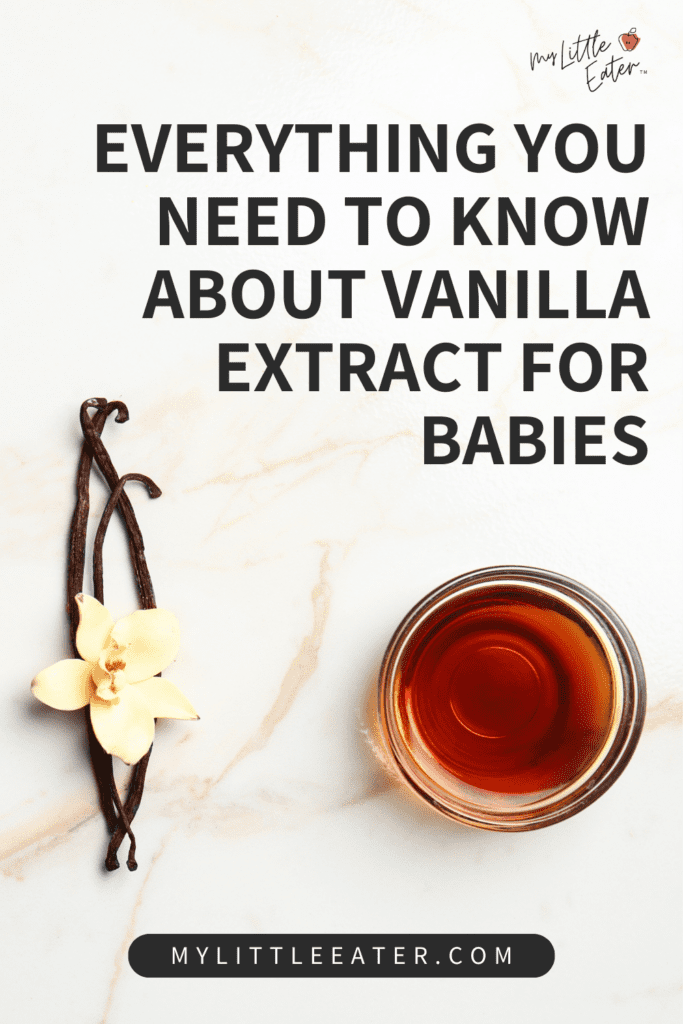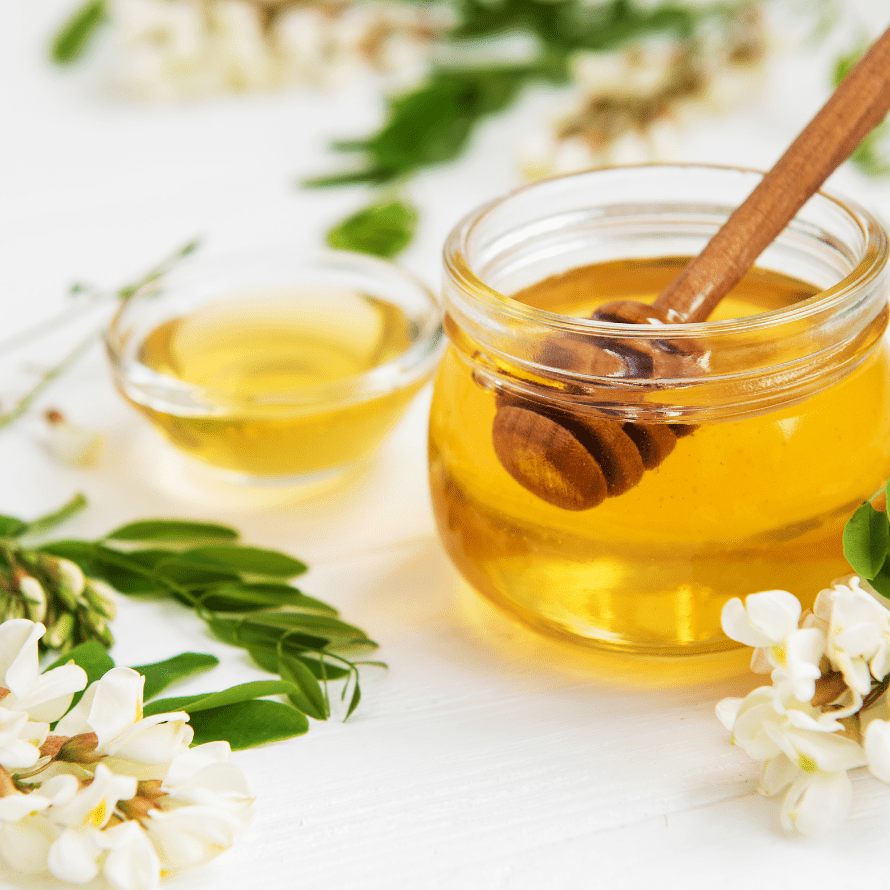- No Comments
- Bianca Gruenewald, RD(c)
Vanilla extract…does it really contain alcohol!? How much alcohol? And most importantly…is it even safe for babies?
If you’ve asked yourself these questions before, you’re not alone.
In this blog, we’re going to cover everything you need to know about vanilla extract. From why it contains alcohol, to how to serve it safely to your baby, and everything in between. We’ll even share one of our favorite ways to use vanilla extract in a baby-friendly recipe. So, let’s get into it!
If you want to take the stress out of deciding what meals to serve, and how to safely serve them to your baby, you’ll love our 60 Day Baby Led Feeding Meal Plan!
Created by dietitians, the meal plan introduces over 100 new foods in 60 days! You can feel confident knowing that your baby is getting the exposure to new foods and textures they need to prevent picky eating – with no extra planning or time wasted for you!
Table of Contents
Vanilla extract is a common ingredient used to add flavor to many recipes. It can be found in things like muffins, pancakes, cookies, and even oatmeal.
It’s so commonly used that you may have never even questioned including it in a recipe for your baby until you read something online about its alcohol content and worry immediately set in! But, don’t worry mama – we’re here to put your mind at ease.
Is vanilla extract safe for babies?
In short – YES! Vanilla extract is safe for babies to consume in the small amount typically included in foods (1).
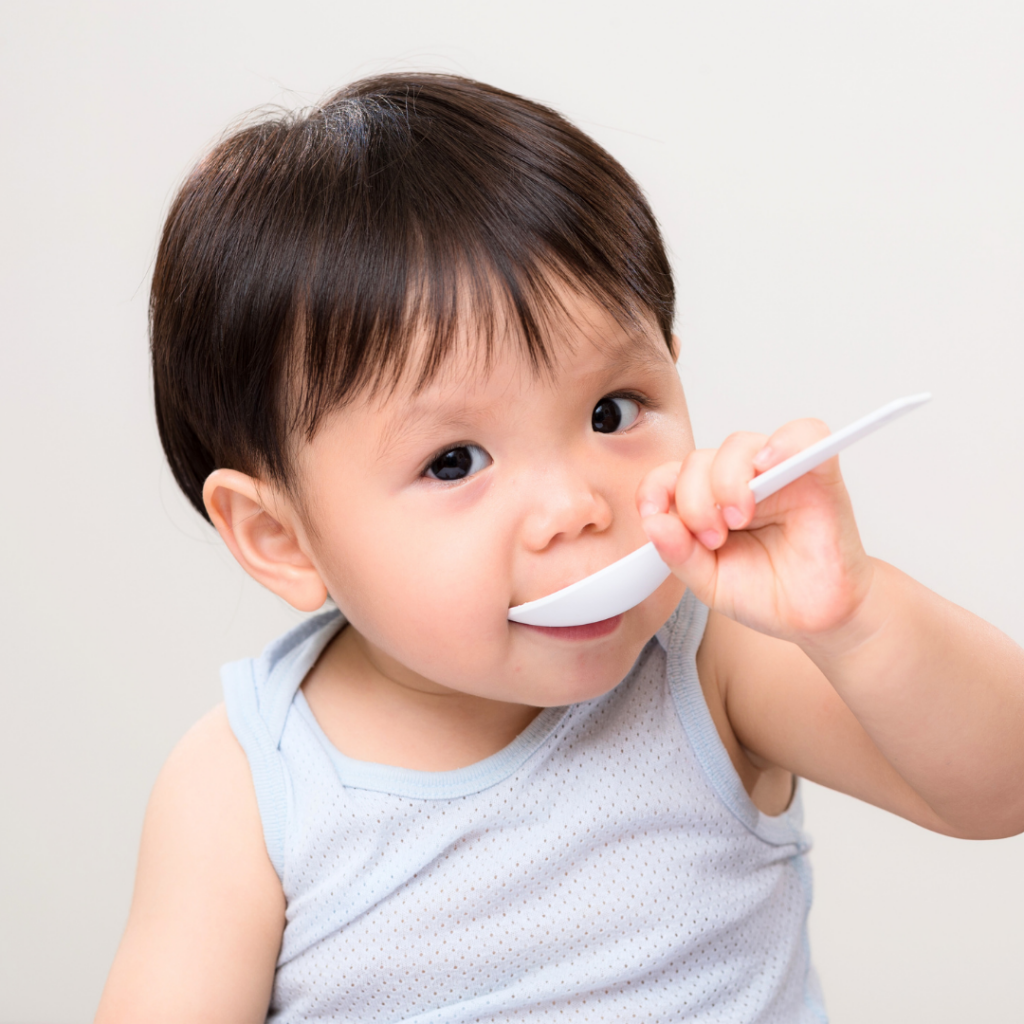
We understand that you may be concerned about the alcohol in vanilla extract. However, vanilla is typically added to foods in VERY small amounts. Not much is needed to provide that sweet vanilla taste that we all know and love!
Plus, foods that contain vanilla extract are almost always cooked. The heat from cooking causes the alcohol to evaporate, which means that little to no alcohol is left in the final product. So, give your baby a bite of that muffin they’re reaching for…without the stress!
When can babies have vanilla extract?
Your baby can safely eat foods containing vanilla extract right away at around 6 months of age!
A common misconception is that babies can only eat foods that are bland, but… this is a myth! It’s recommended to include spices, herbs, and various flavors in food for your baby from day one of starting solids.
How much alcohol is in vanilla extract?
Let’s start with the basic question of “Why on earth is there alcohol in vanilla extract anyway?”.
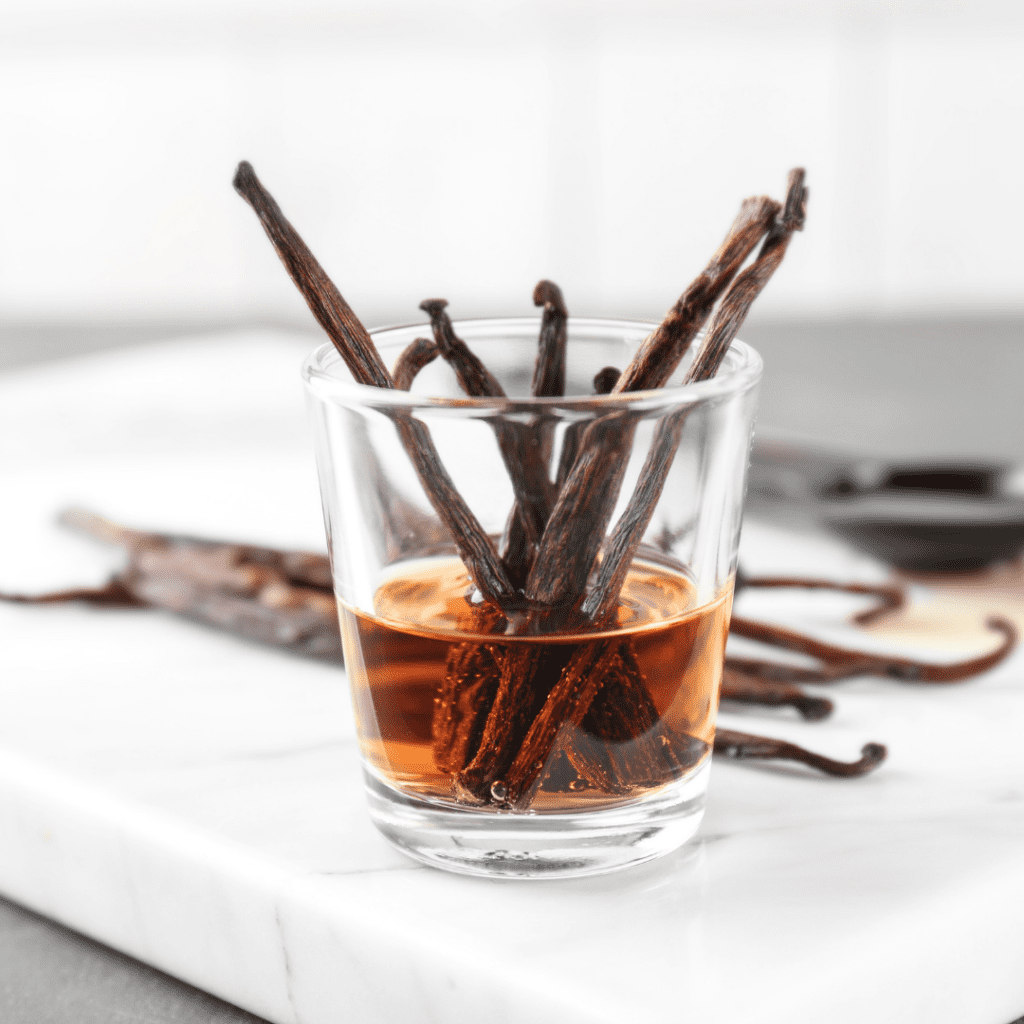
Simply put, alcohol is an ingredient used during the production of vanilla extract. The alcohol is what’s used to help extract a compound called vanillin from the vanilla beans themselves. Vanillin is what gives vanilla extract its signature smell and taste (2).
According to the Food and Drug Administration (FDA), pure vanilla extract must contain at least 35% alcohol by volume (3). This is to make sure that an appropriate amount of vanillin is present in the final product.
Artificial vanilla extract still contains alcohol but in a much smaller amount (as little as 2%). More on artificial vanilla extract later!
Now, before you get totally freaked out by the sound of “35% alcohol” and jump to concerns about alcohol poisoning – let’s put this into context.
If you add one teaspoon of vanilla extract into a recipe that makes 12 muffins, each muffin will only contain 0.14mL of alcohol before being baked. On top of this being a super small amount of vanilla, as we mentioned earlier, most of the alcohol in vanilla extract evaporates once it’s cooked. This means that essentially no alcohol will be left in the muffin once it’s finished baking.
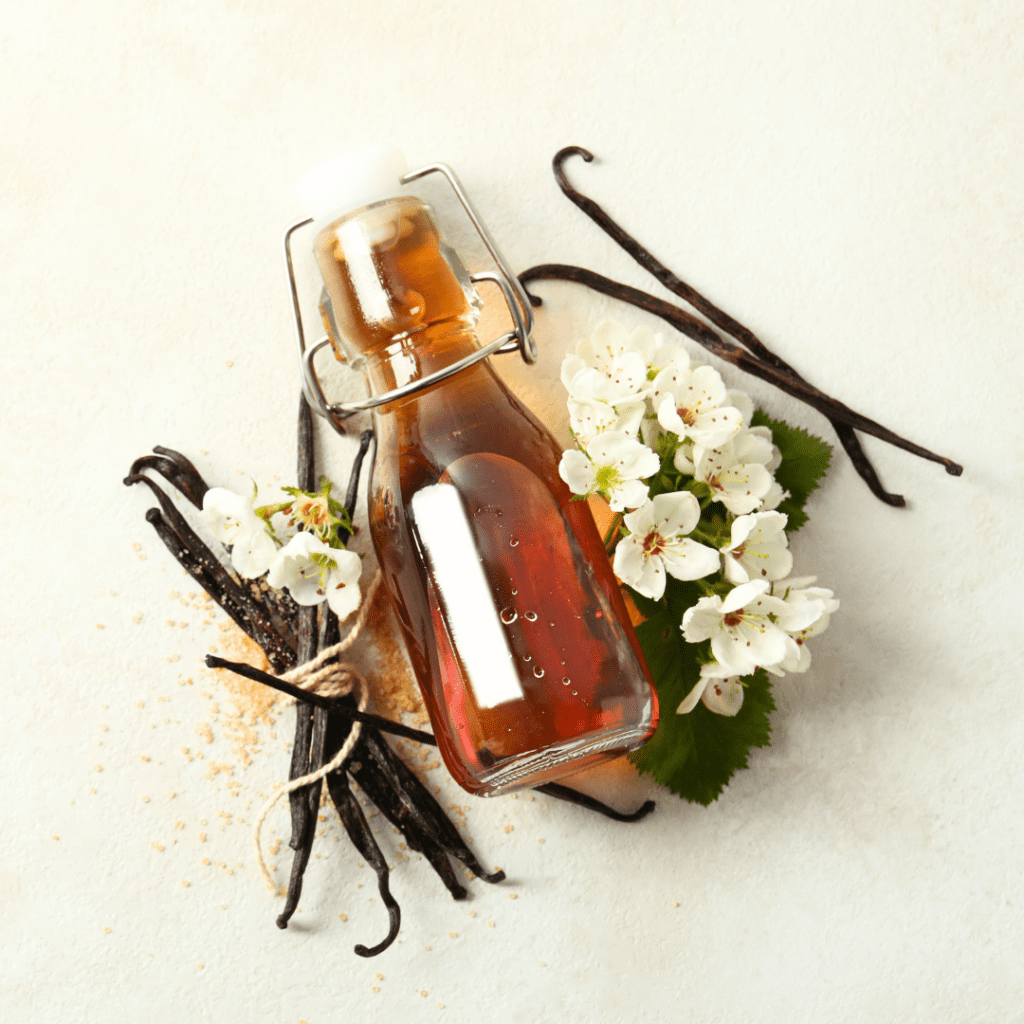
Benefits of offering vanilla extract to babies
Not only is vanilla extract safe for your baby to consume but including it in foods for your baby can actually be beneficial! Here are our top 3 reasons to include vanilla in the foods you serve your baby.
Introduces baby to new flavors
Our favorite benefit of including vanilla in foods for your baby is that it introduces a new flavor to them!
There’s a critical period early on in feeding when babies are developing their taste and texture preferences. Babies may also be more willing to try new foods and flavors during this time, which is between 6-9 months of age.
Because of this, the more flavors that you can introduce to your baby early on, the more likely they will be to like and accept a wide variety of foods long-term (4). Adding spices and flavors like vanilla to foods is an easy way to get those flavor exposures up!
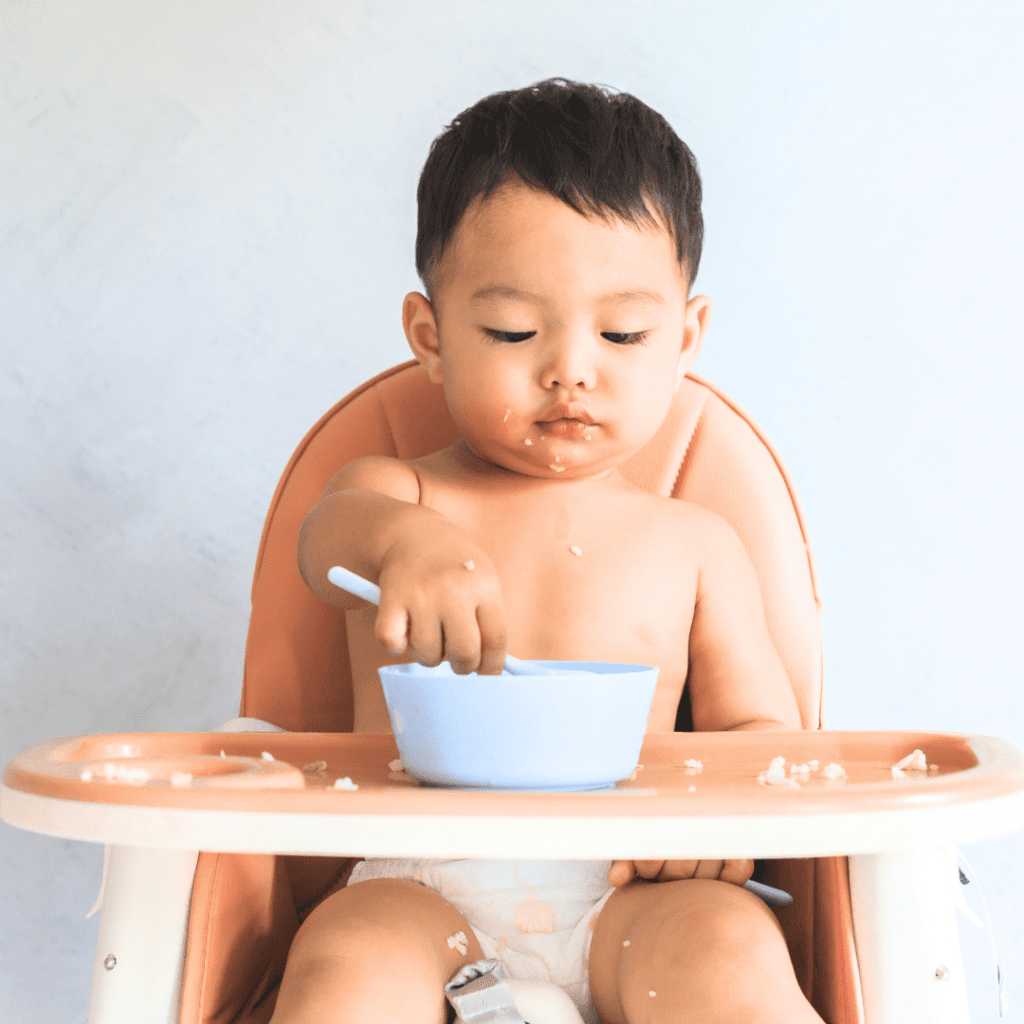
Improves flavor without added sugar
Adding vanilla extract to a recipe for your baby is a great way to add a hint of sweetness and improve flavor! By adding vanilla, you can eliminate the need for added sugar, which we want to avoid for babies under the age of two.
Potential health benefits
This is the lowest on the list because while it is interesting, there just isn’t enough evidence available yet for us to be too excited about it.
Vanillin (the main compound in vanilla) may have some anti-inflammatory, anti-bacterial, and antioxidant properties. From what we know right now, these benefits are small, and more research is needed before we can start using vanilla for anything other than to add flavor to food – but it’s worth noting (5).
What is the best vanilla for babies?
The best vanilla for your baby is the one that you feel most comfortable serving them based on your personal values.
To help you make an informed decision, we’re going to compare the different vanilla options out there because there are actually quite a few to choose from. Let’s dive in!
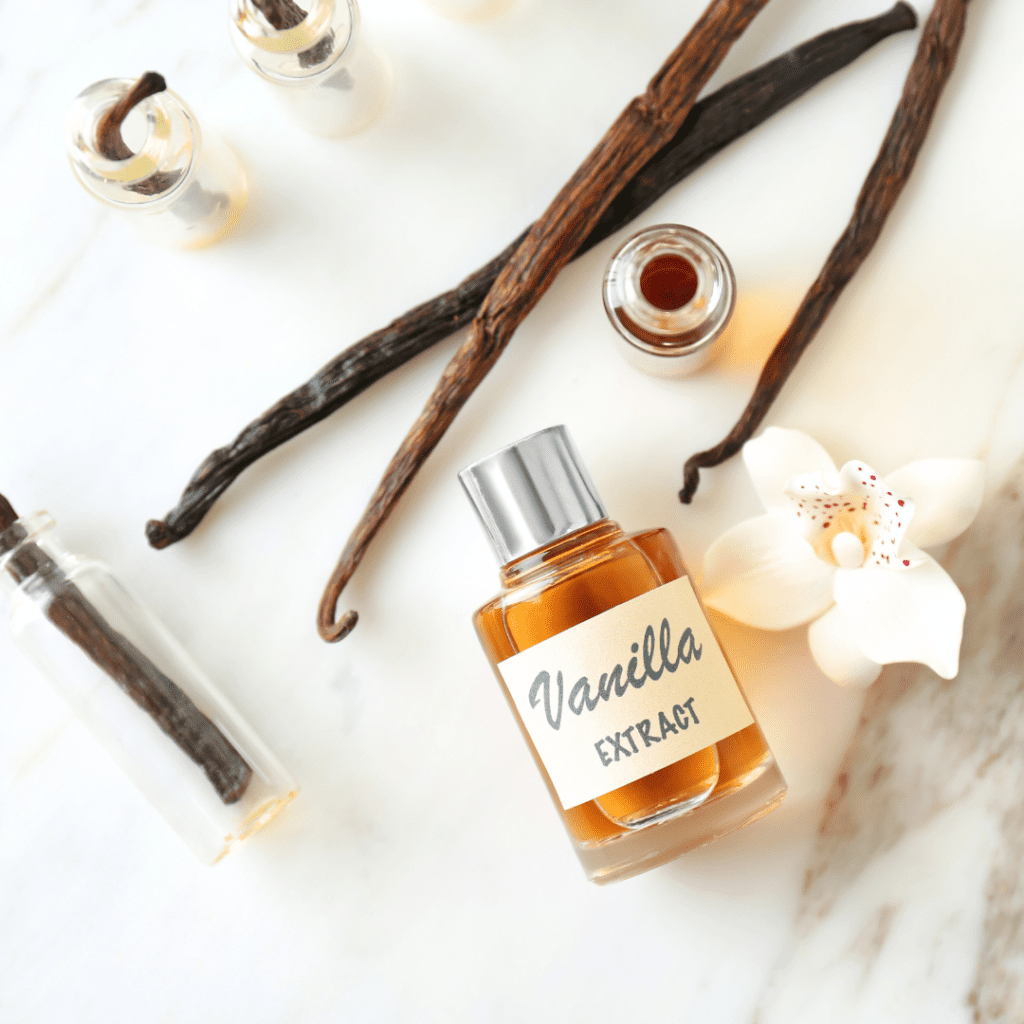
Pure Vanilla Extract
We love pure vanilla extract for its rich depth of vanilla flavor. This richness comes from the fact that pure vanilla has a high concentration of vanillin.
Typically, the only ingredients in pure vanilla extract are vanilla beans and alcohol (so this is the one with the highest alcohol content). It’s usually easy to track down in the baking aisle of grocery stores, but it does tend to be more expensive than other alternatives, like artificial vanilla extract.
Artificial Vanilla Extract
Unlike pure versions, artificial vanilla extract uses chemical compounds to create the flavor and smell of vanilla. Today, most artificial vanilla extract is derived from a compound called guaiacol, which is generally recognized as safe by the FDA (6).

Because of the way artificial vanilla extract is made, it has a lower alcohol content (as low as 2%). Artificial options are also much less expensive than pure vanilla extracts. The downside is that the taste and smell of artificial vanilla are usually not as strong or complex as pure vanilla. (7)
We love pure vanilla extract for its simple ingredients and rich flavor. But, if pure vanilla is not accessible to you, artificial vanilla extract is still a safe option to include in foods for your baby!
Vanilla Flavoring
Vanilla flavoring also uses chemicals to mimic the flavor and smell of vanilla. But, unlike artificial vanilla extract, vanilla flavoring sometimes contains added sweeteners. This is important to be aware of because it’s recommended to avoid giving added sugar to babies under two years of age.
If you choose to include imitation vanilla in a recipe for your little one, make sure to use one that does not contain added sugar.
Organic Vanilla Extract
When a vanilla extract is labeled as organic, the vanilla beans used to make it are grown without certain pesticides, herbicides, or synthetic fertilizers. It also means that the company selling the vanilla extract paid extra to have this confirmed and written on their label.
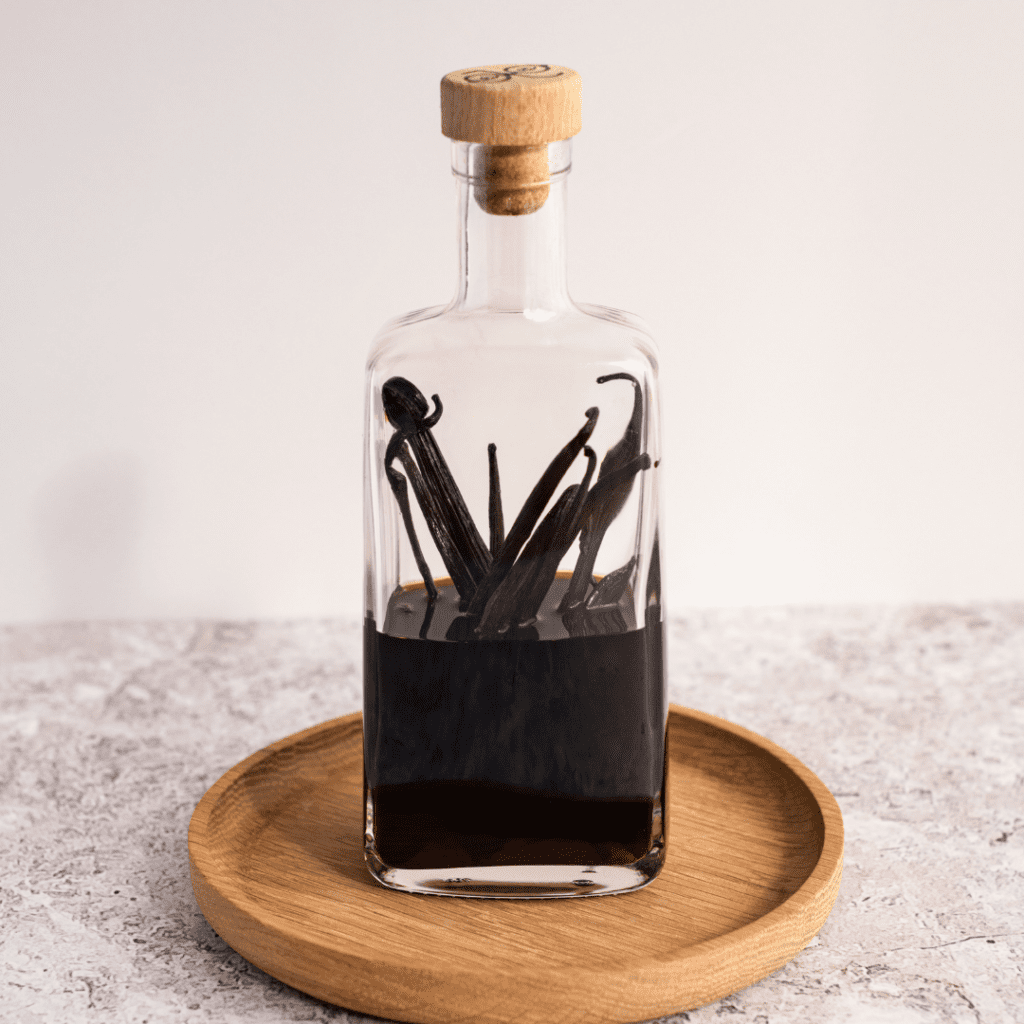
That being said, vanilla bean is not a crop that is commonly sprayed with pesticides, herbicides, or synthetic fertilizers anyway, so searching far and wide for an organic option may not be completely necessary.
Learn more about when to shop for organic foods for your baby.
Aside from the way that the vanilla beans are grown, organic vanilla extract is basically the same thing as pure vanilla extract. However, organic vanilla extract tends to come with a higher price tag and can be more difficult to find in stores.
This one is really about personal preference. If you have access to it and prefer to shop organic, this is a good option. If you don’t have access to organic vanilla (or would just rather a more affordable option) that’s fine too!
Alcohol-Free Vanilla Extract
Alright, so you know that vanilla extract containing alcohol is safe – BUT – you still feel more comfortable offering something with no alcohol in it at all? No problem! Alcohol-free options do exist.
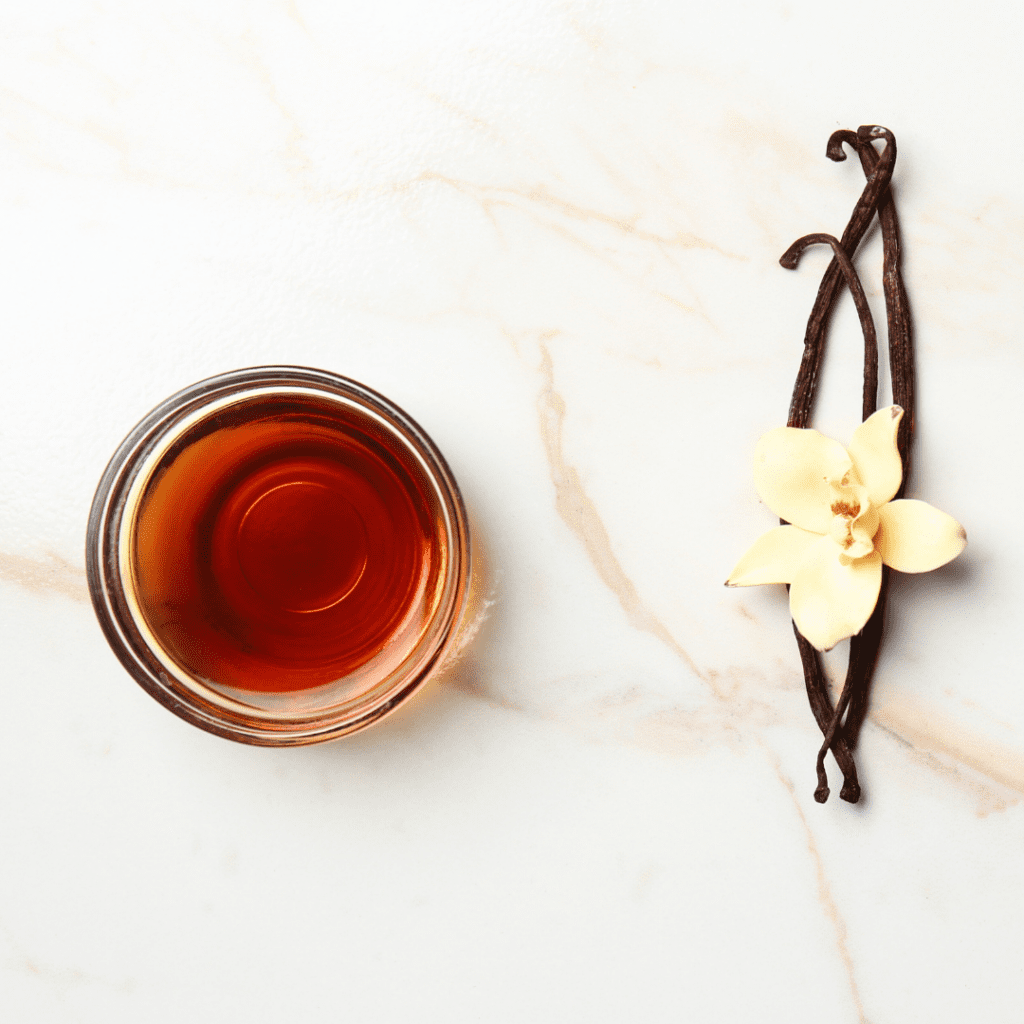
Remember earlier when we explained how alcohol is used to extract the vanillin from vanilla beans? Well, vanillin can also be extracted from vanilla beans using an ingredient called glycerin. Glycerin is found naturally in both plant and animal fat, and can also be made synthetically (8). It is recognized as safe by the FDA (and we aren’t concerned about its use either!) (9).
Alcohol-free vanilla extract can be more difficult to find in stores, but they are out there! Whether you decide to choose vanilla extracted using alcohol or glycerin is up to you, both are safe choices for your baby.
Vanilla Beans
Last but not least…vanilla beans! If you’ve ever used fresh vanilla bean, you’ll know that its deep vanilla flavor is unmatched. And don’t even get us started on the sweet, almost toasty smell – so good!
Vanilla bean is also a great option if you’re looking for a naturally alcohol-free way to introduce vanilla to your baby.
Vanilla beans can be found in the spice section of some grocery stores. Before you go looking for it and get sticker shock, let us warn you that out of all the vanilla options we’ve talked about, vanilla beans are the most expensive.
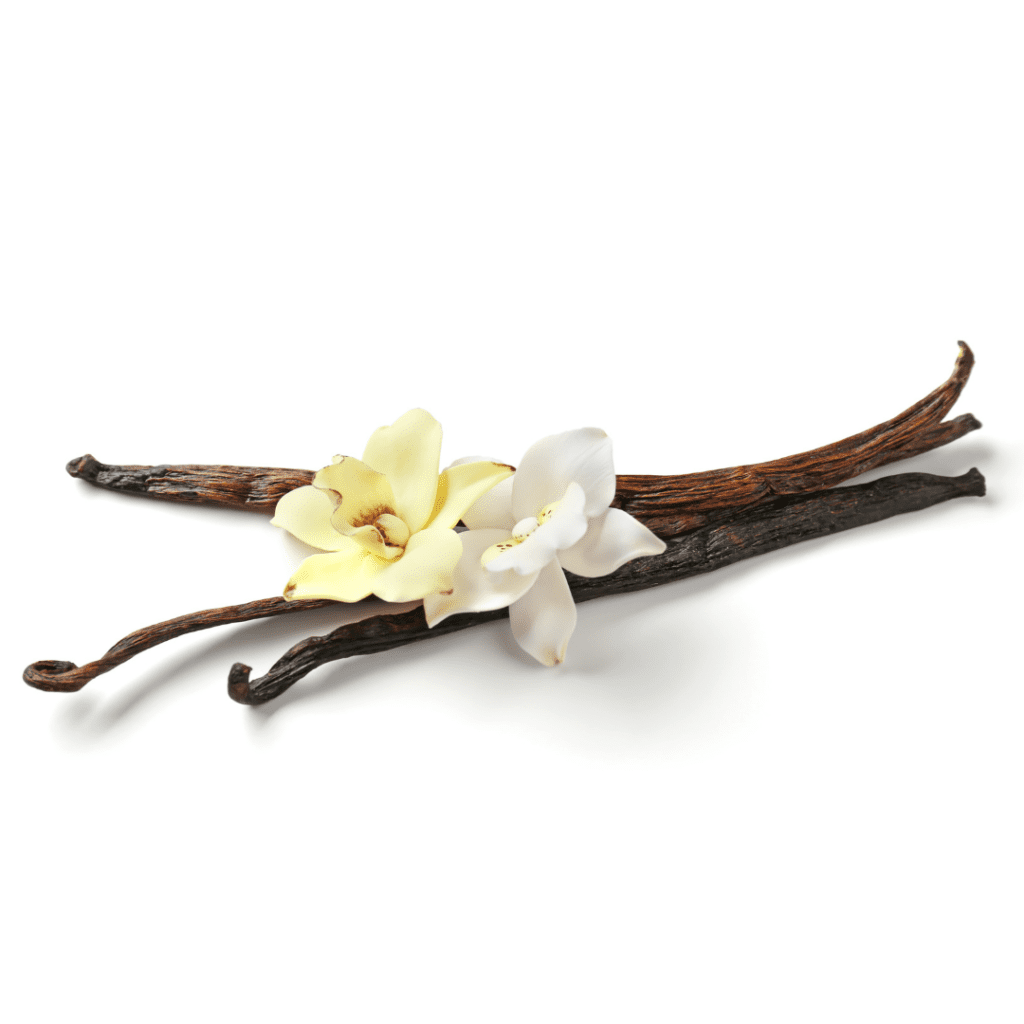
How to use vanilla bean pods
If you decide to use vanilla bean in a recipe for your baby, just know that it is a little bit more complicated than using liquid vanilla extract. One teaspoon of liquid vanilla extract is equal to about a 2-inch long piece of vanilla bean.
To use vanilla bean in a recipe, use a sharp knife to carefully cut a slit along the vanilla bean lengthwise. Pry open the vanilla bean so that the soft inner center of the pod is exposed, then scrape out the center and add it to your recipe.
Key Takeaway
Pure vanilla extract, artificial or imitation vanilla extract, and vanilla bean are all safe options to include in food for your baby. The type of vanilla that you choose is up to you and what works best for your family.
Key Takeaway
Pure vanilla extract, artificial or imitation vanilla extract, and vanilla bean are all safe options to include in food for your baby. The type of vanilla that you choose is up to you and what works best for your family.
When vanilla extract is not recommended
While foods containing vanilla extract are safe for babies to consume, there are a few situations where we do not recommend vanilla extract for babies. Let us explain when that is and the details of why.
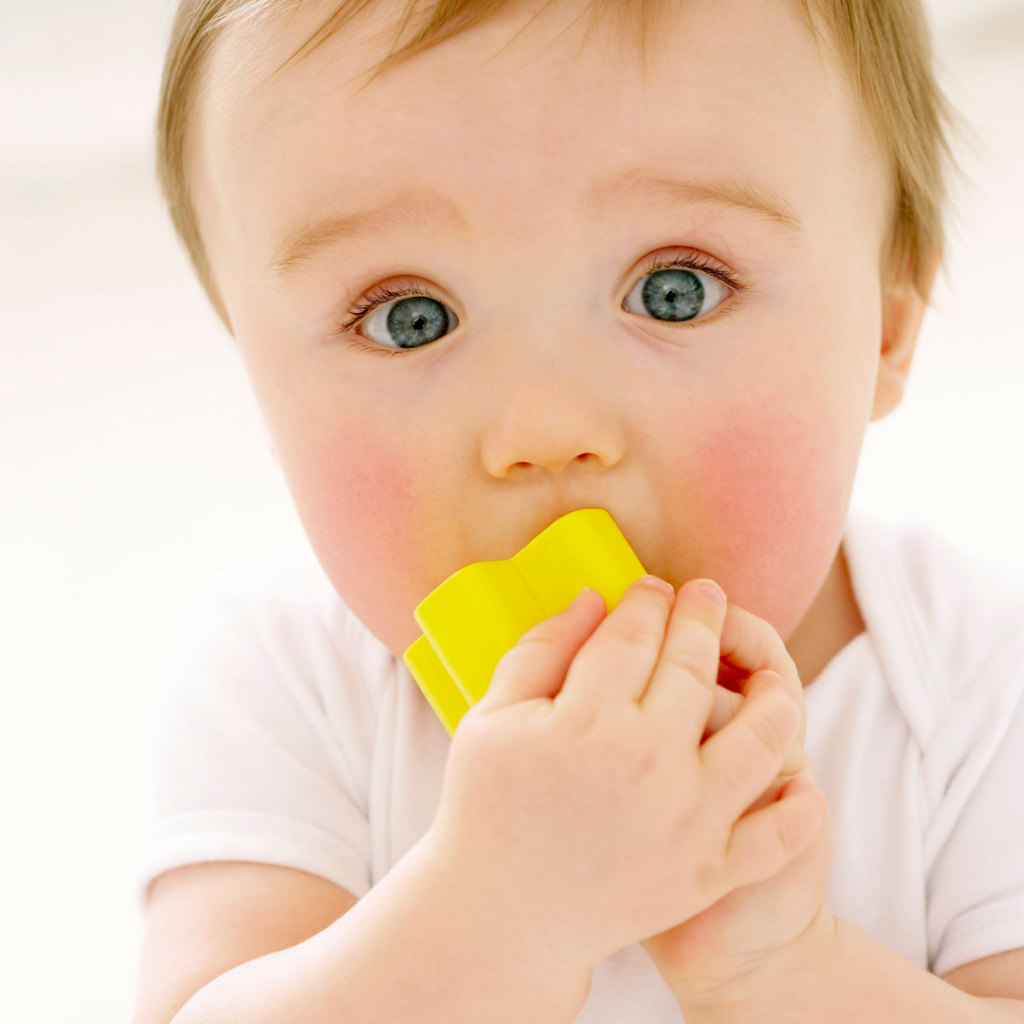
To help ease the pain of teething
Although you may have seen people recommend rubbing vanilla extract on your baby’s gums as a natural pain reliever, there’s NO evidence that vanilla extract is safe or effective as a teething remedy.
If you can believe it, this trend came from the 1800s when parents would rub pure whiskey or rum on their baby’s gums to numb the pain of teething. (10) There are even tales that some parents went as far as to add alcohol into their baby’s milk to help “numb the pain”.
We think it goes without saying that this is no longer an acceptable thing to do! But just to be clear…alcohol is dangerous for babies, and giving alcohol to your baby is never recommended.
For this reason, rubbing vanilla extract that contains 35% alcohol (close to the percentage found in whiskey) on your baby’s gums is just not worth the risk. When you do this, all of the alcohol will be absorbed directly into your baby’s system. This is very different than including a few drops of vanilla extract into a cooked, or even an uncooked, recipe that is meant for several servings.
Vanilla extract is only safe for babies when used as intended – to add flavor to foods.
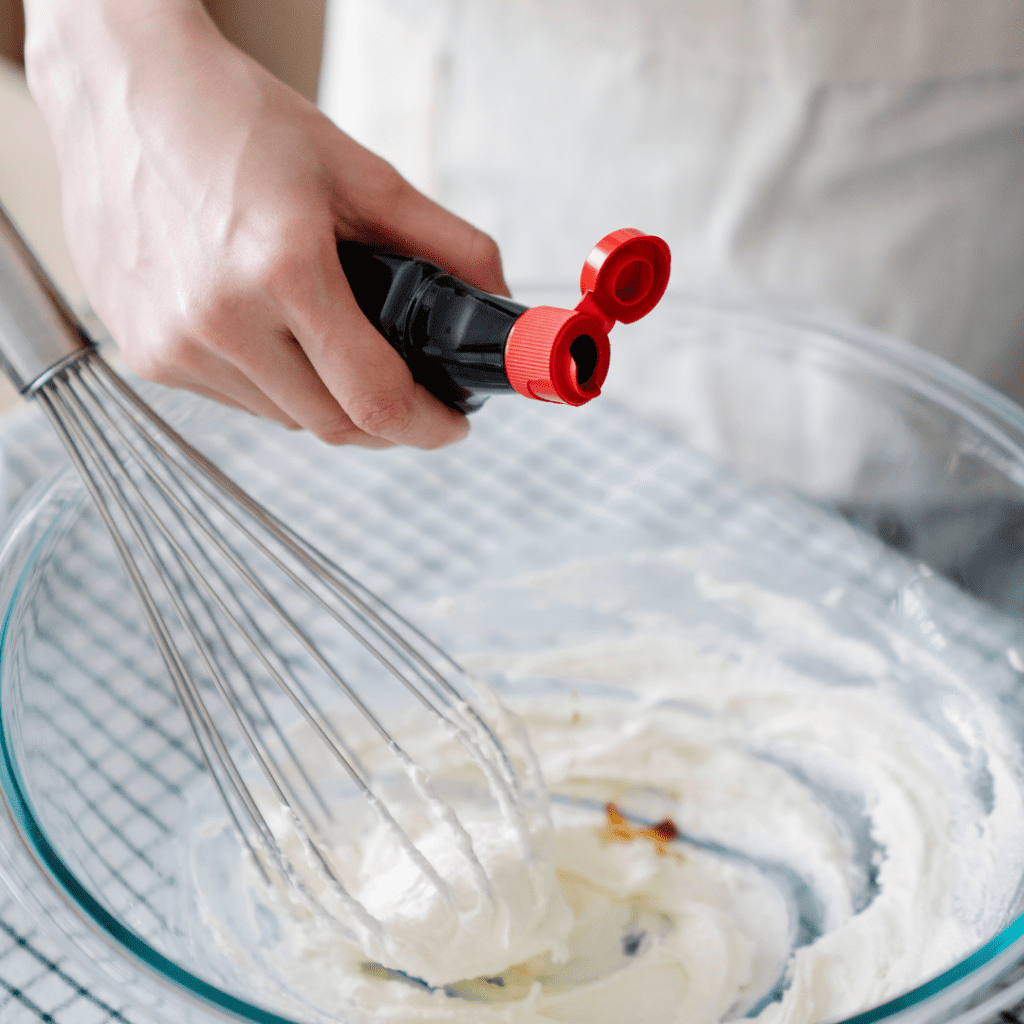
To improve the taste of breast milk or formula
In short, we do not recommend that you add vanilla extract to breast milk or formula. Vanilla extract is only safe when added in small quantities to your baby’s food.
A common argument for adding vanilla extract to breast milk is that it can give the milk a sweeter taste and make it more appealing to your baby when your breast milk is higher in lipase. Lipase is an enzyme naturally found in breast milk, and not only is it safe, but it’s actually a good thing! Lipase helps make the fat in milk easier for babies to digest (11).
Since the composition of breast milk can change depending on what babies need, there can be times when lipase content may be higher, which can affect flavor (12). High lipase can cause milk to have a soapy smell or taste, which most babies are unbothered by.
Breast milk, high lipase or not, is completely safe and nutritious and does not need to be modified.
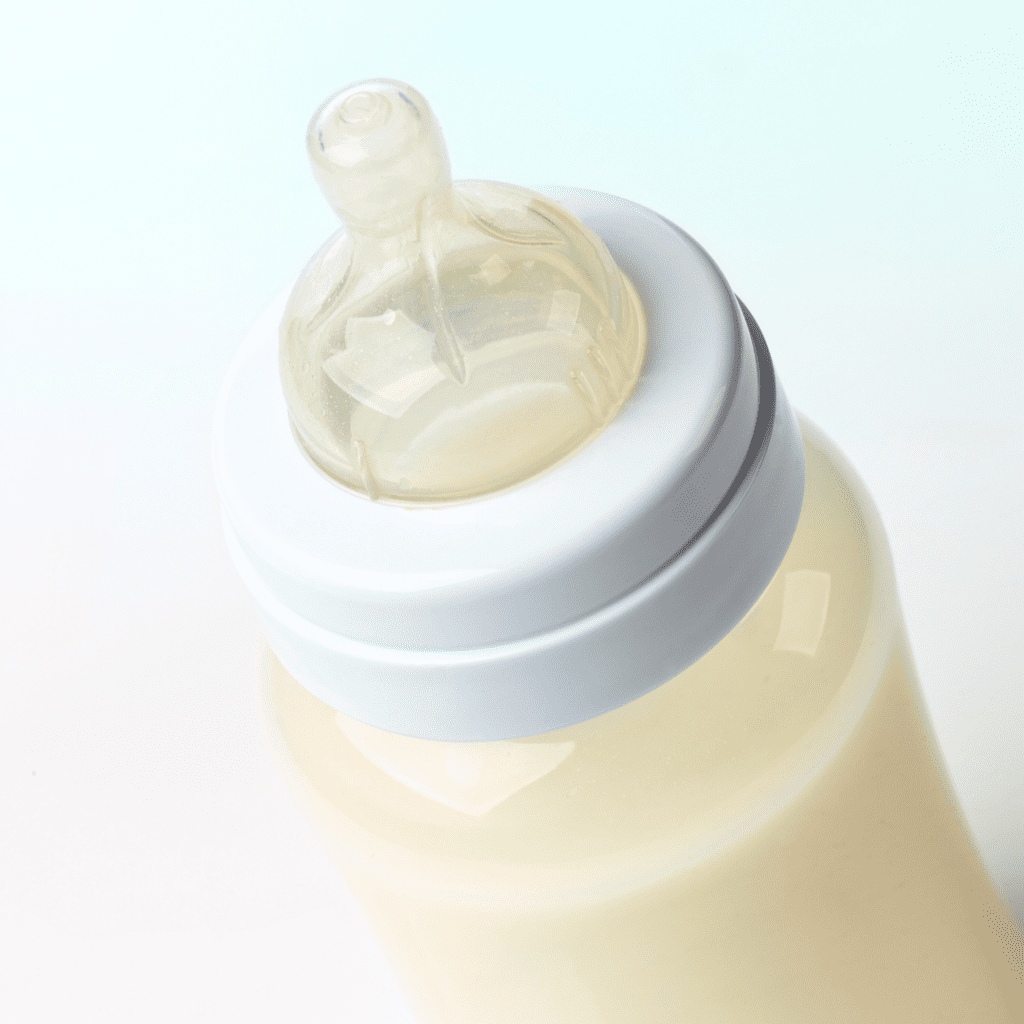
As for formula, some people swear by adding vanilla extract to help offset the strange smell formulas tend to have. However, it’s important to note that even though we may be bothered by the smell of baby formula (we know…it can smell pretty bad) most babies are not phased by it.
So again, it is not necessary to alter or infuse milk (ie. breast milk or formula) with any type of vanilla extract, and in our opinion, it just isn’t worth the risk.
To replace standard insect repellents
It’s been brought to our attention that pure vanilla extract (ie. the type with high alcohol content) is being broadcasted as a “natural” and “safe” alternative to standard insect repellents. While not feeding-related, we felt compelled to include this as it is not recommended for use in this manner.
As mentioned above, pure varieties contain a minimum of 35% alcohol by volume. This is not something you want to be rubbing all over the skin of your baby or toddler. Not only can the application of alcohol directly on the skin cause irritation and contact dermatitis, but small amounts of alcohol can be absorbed through the immature skin of babies and young children (13).

So, in the quantities of vanilla extract that would be required to cover your child’s entire body, the risk is simply not worth the minimal protection of around thirty minutes that research suggests may be provided (14).
If you’re concerned with certain ingredients of standard insect repellents, speak with your child’s doctor about the research and what they would recommend instead.
Vanilla FAQs
Is vanilla a top allergen?
No, vanilla is not considered a top allergen. While it is technically possible to be allergic to any food, an allergy to vanilla is not common (15).
Can vanilla cause contact dermatitis?
There have been some cases of vanilla causing a small localized rash called contact dermatitis. Research suggests that those who are sensitive to a compound called Balsam of Peru may develop a contact rash from food flavorings that contain vanillin, as the two compounds are related (16).
It’s important to know that a contact dermatitis rash is not harmful – not to be confused with an allergic reaction. Contact dermatitis appears in areas that came into contact with the food, typically around the mouth and on the hands. It doesn’t spread throughout the body like a rash caused by an allergic reaction would.
If you notice that your baby has this reaction, you can apply a barrier cream around the mouth and cheeks before eating to help prevent it.
Can vanilla be introduced for the first time with other new foods?
Yes! It’s a common misconception that new foods need to be introduced one at a time. The only exception to this rule is with the introduction of new foods that are top allergens. Since an allergy to vanilla is uncommon, there’s no need to worry about introducing it at the same time as another new food.
Okay, now that you’re an expert on all things vanilla extract for your baby, you may already be trying to think of a way to introduce it for the first time. We’ve got you covered mama! Here’s an easy and delicious baby led weaning recipe that you can use to introduce your little one to the flavor of vanilla.
And if you’re looking for more baby-friendly recipes, don’t forget to check out our 60 Day Baby Led Feeding Meal Plan! Take the stress out of deciding what meals to serve and how to safely serve them to your baby with access to over 60 dietitian-approved recipes, weekly grocery lists, serving and nutrition tips, and more!
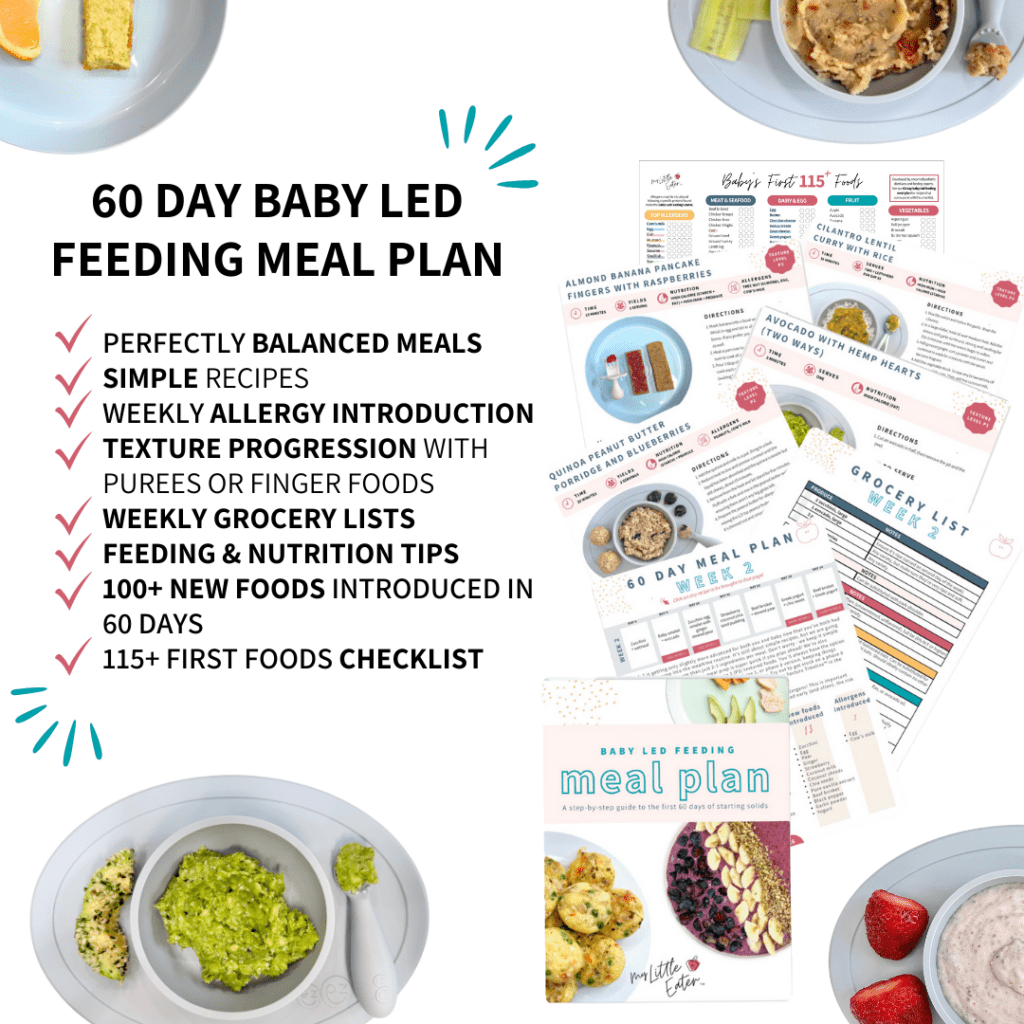
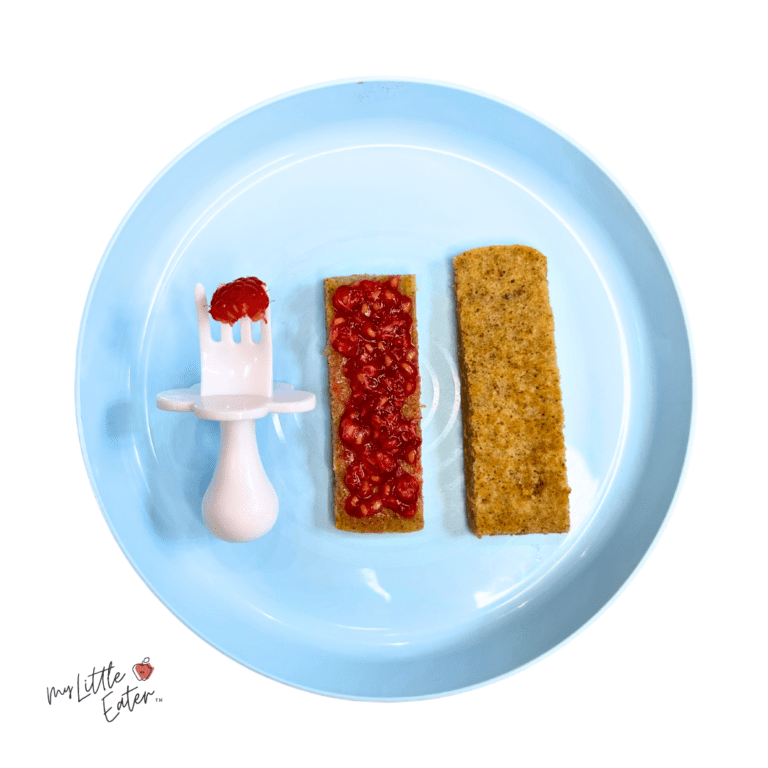
Vanilla Almond Pancake Fingers with Raspberries
Equipment
- mixing bowl
- skillet
Ingredients
- 1 egg
- 1 banana
- 1 tbsp natural almond butter
- cooking spray
- ¼ tsp vanilla extract
- ¼ cup raspberries (fresh, or thawed from frozen)
Instructions
- Preheat a non-stick skillet on low heat. Lightly spray with oil.
- Combine the ingredients in a blender (or mash well with a fork in a mixing bowl).
- Pour 3 tablespoons of batter on the skillet for each pancake. Cook for 3-5 minutes on each side, flip when the top is bubbling. Let cool slightly and cut into long, finger-shaped strips.
- Mash raspberries using the back of a fork then spread them onto the pancake strips. Flatten a few of the remaining raspberries slightly using a fork, then serve whole for baby to pick up using their pincer grasp, or pre-loaded onto a baby safe fork.
Notes
Did you find this helpful? Pin it to save for later!
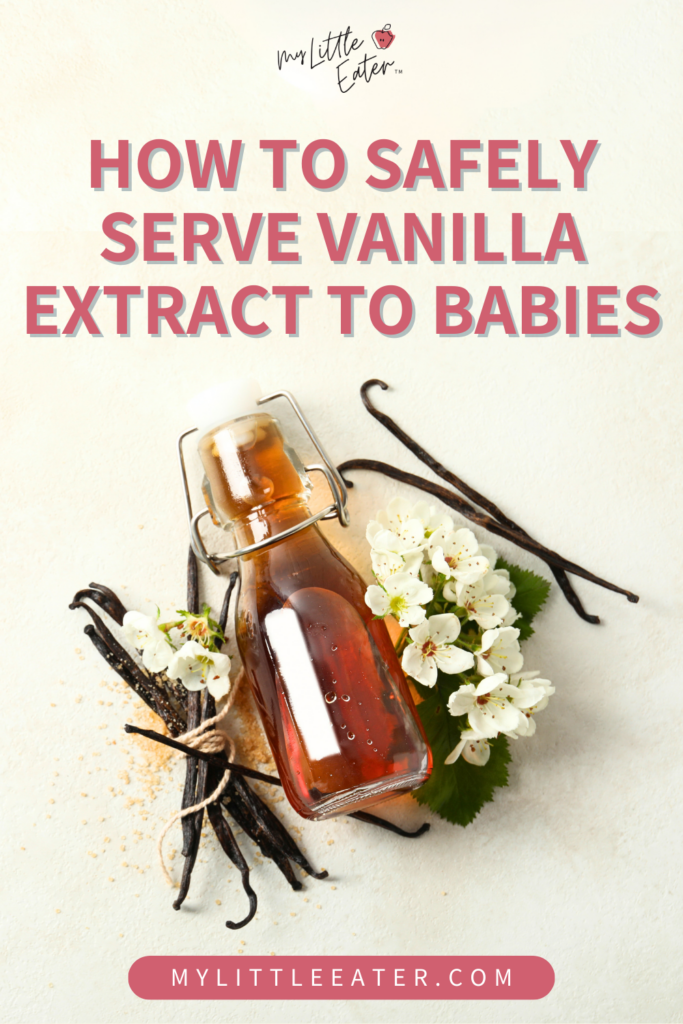

Bianca Gruenewald, RD(c)
Bianca is a Registered Dietitian Candidate and works in a client support role at My Little Eater Inc. She's a dog-mom to Coco, and a proud auntie to her three year old niece and four year old nephew!

Bianca Gruenewald, RD(c)
Bianca is a Registered Dietitian Candidate and works in a client support role at My Little Eater Inc. She's a dog-mom to Coco, and a proud auntie to her three year old niece and four year old nephew!
References
- U.S. Food & Drug Administration. (2023). Substances Generally Recognized as Safe: Spices and other natural seasonings and flavorings. https://www.accessdata.fda.gov/scripts/cdrh/cfdocs/cfcfr/CFRSearch.cfm?fr=182.10
- Sinha, A. K., Sharma, U. K., & Sharma, N. (2008). A comprehensive review on vanilla flavor: extraction, isolation and quantification of vanillin and others constituents. International journal of food sciences and nutrition, 59(4), 299–326. https://doi.org/10.1080/09687630701539350
- U.S. Food & Drug Administration. (2023). Requirements for Specific Standardized Food Dressings and Flavorings: Vanilla Extract. https://www.accessdata.fda.gov/scripts/cdrh/cfdocs/cfcfr/cfrsearch.cfm?fr=169.175
- Harris, G., Mason, S. Are There Sensitive Periods for Food Acceptance in Infancy?. Curr Nutr Rep 6, 190–196, 2017. https://doi.org/10.1007/s13668-017-0203-0
- Arya, S. S., Rookes, J. E., Cahill, D. M., & Lenka, S. K. (2021). Vanillin: a review on the therapeutic prospects of a popular flavouring molecule. Advances in Traditional Medicine, 21(3), 1–17. https://doi.org/10.1007/s13596-020-00531-w
- U.S. Food & Drug Administration. (2024). Substances Added to Food (formerly EAFUS). https://www.cfsanappsexternal.fda.gov/scripts/fdcc/index.cfm?set=FoodSubstances&id=GUAIACOL
- Khoyratty, S., Kodja, H., & Verpoorte, R. (2018). Vanilla flavor production methods: a review. Industrial Crops and Products, 125, 433-442. https://doi.org/10.1016/j.indcrop.2018.09.028
- EFSA Panel on Food Additives and Nutrient Sources added to Food (ANS), Mortensen, A., Aguilar, F., Crebelli, R., Di Domenico, A., Dusemund, B., Frutos, M. J., Galtier, P., Gott, D., Gundert-Remy, U., Leblanc, J. C., Lindtner, O., Moldeus, P., Mosesso, P., Parent-Massin, D., Oskarsson, A., Stankovic, I., Waalkens-Berendsen, I., Woutersen, R. A., Wright, M., … Lambré, C. (2017). Re-evaluation of glycerol (E 422) as a food additive. EFSA journal. European Food Safety Authority, 15(3), e04720. https://doi.org/10.2903/j.efsa.2017.4720
- U.S. Food & Drug Administration. (2023). Food Additive Status List. https://www.fda.gov/food/food-additives-petitions/food-additive-status-list
- Smitherman, L. C., Janisse, J., & Mathur, A. (2005). The use of folk remedies among children in an urban black community: remedies for fever, colic, and teething. Pediatrics, 115(3), e297–e304. https://doi.org/10.1542/peds.2004-1443
- Koletzko, B. (2016). Human Milk Lipids. Annals of nutrition & metabolism, 69(2), 28–40. https://doi.org/10.1159/000452819
- Andreas, N.J., Kampmann, B., Mehring Le-Doare, K. (2015). Human breast milk: A review on its composition and bioactivity. Early Human Development, 91(11), 629-635. DOI: 10.1016/j.earlhumdev.2015.08.013
- Lachenmeier D. W. (2008). Safety evaluation of topical applications of ethanol on the skin and inside the oral cavity. Journal of occupational medicine and toxicology (London, England), 3, 26. https://doi.org/10.1186/1745-6673-3-26
- Gitahi, S. M., Piero, M. N., Mburu, D. N., & Machocho, A. K. (2021). Repellent Effects of Selected Organic Leaf Extracts of Tithonia diversifolia (Hemsl.) A. Gray and Vernonia lasiopus(O. Hoffman) against Sitophilus zeamaisMotschulsky (Coeoptera: Curculionidae). TheScientificWorldJournal, 2021, 2718629. https://doi.org/10.1155/2021/2718629
- American Academy of Allergy Asthma & Immunology. (2023). Can Spices Cause Allergic Reactions? https://www.aaaai.org/tools-for-the-public/conditions-library/allergies/can-spices-cause-allergic-reactions#:~:text=Anaphylaxis%20(severe%20allergic%20reaction).,seed%2C%20cumin%20and%20cayenne%20pepper.
- Katta, R., & Schlichte, M. (2014). Diet and dermatitis: food triggers. The Journal of clinical and aesthetic dermatology, 7(3), 30–36.
